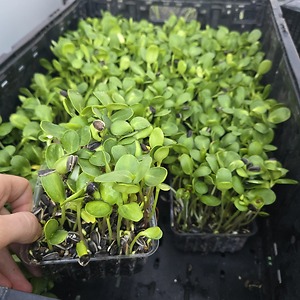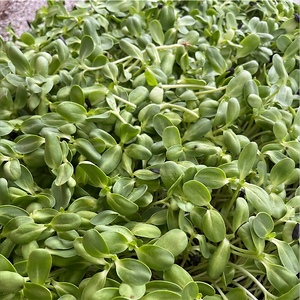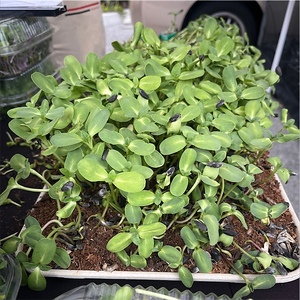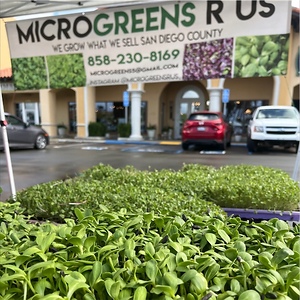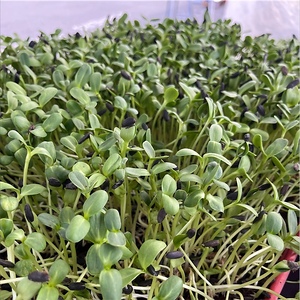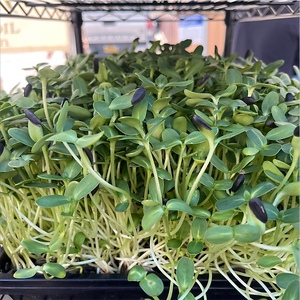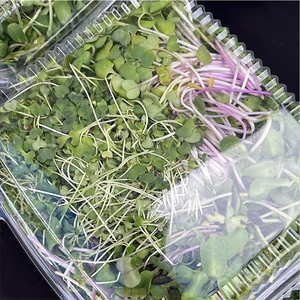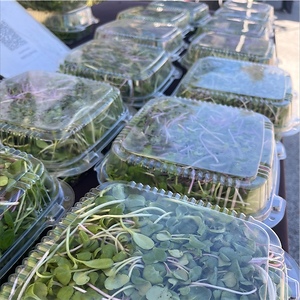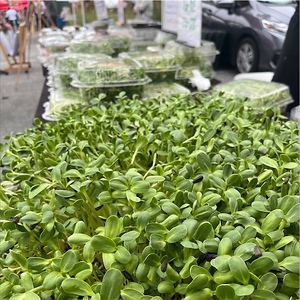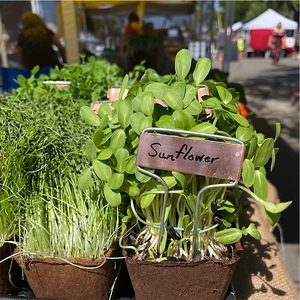


Sunflower Greens Sprouts
This product is organically grown.
Specialty Produce is certified to handle organics.
Our California registration number is: 37-1293 Organically grown.
Estimated Inventory, 5 lbs : 1.00
This item was last sold on : 08/14/23
Description/Taste
Sunflower sprouts consist of slender white to yellow shoots, slightly thinner than a bean sprout, capped with two petite leaves. The dark green leaves are oval to oblong in shape with uniform, curved edges. The leaf’s surface is also smooth, pliable, and thin, sometimes bearing a slight crease down the center. Attached to the leaf, the shoots are crisp, semi-aqueous, and succulent, offering a slightly chewy consistency. Sunflower sprouts have a pleasing texture, reminiscent of spinach, and contain a refreshing, vegetal, and slightly nutty taste with nuances of lemon, almond, and seeds.
Seasons/Availability
Sunflower sprouts are available year-round.
Current Facts
Sunflower sprouts, botanically classified as Helianthus annuus, are the young seedlings of the well-known bright yellow flower belonging to the Asteraceae family. The sprouts are sometimes labeled as Sunflower shoots or microgreens and are favored by chefs and home gardeners for their easy-to-grow nature. Sunflower sprouts are ready for harvest in approximately two weeks, and the greens are unique from other sprouts as they cannot be grown in water alone and require soil to germinate. While somewhat unknown in commercial markets, Sunflower sprouts are frequently grown in home kitchens for their crisp and vegetal nature, primarily used raw as an added fresh flavor. The sprouts are also increasing in popularity among chefs as an attractive garnish and through health food stores for their nutritional content.
Nutritional Value
Sunflower sprouts are an excellent source of amino acids, organic compounds that assist in developing muscle, regulating the immune system, and ensure overall proper body functioning. The sprouts also provide vitamin A to maintain organs, potassium to balance fluid levels, calcium and phosphorus to protect bones and teeth, and other minerals such as magnesium, iron, and copper. In Ayurvedic medicine, Sunflower sprouts are believed to aid in lung health and are used as an expectorant to prevent respiratory infections and clear passageways.
Applications
Sunflower sprouts have a crisp, fresh, and slightly nutty flavor well suited for fresh and cooked preparations. The greens can be used raw in any recipe requiring added texture and are typically tossed into salads, layered into sandwiches, wraps, and quesadillas, rolled into sushi, blended into smoothies, or stirred into grain bowls. The sprouts can also be chopped for pesto and other creamy dips. In addition to fresh dishes, Sunflower sprouts can be added at the end of heated preparations to prevent wilting. The greens can be floated on soups, incorporated into mashed potatoes or omelets, mixed into rice, or stir-fried with vegetables or noodles. Sunflower sprouts pair well with vegetables such as radishes, carrots, and kohlrabi, tomatoes, meats such as ham, turkey, and poultry, apples, and herbs including basil, parsley, and dill. The sprouts will keep 2 to 5 days when stored unwashed in a sealed plastic bag in the refrigerator.
Ethnic/Cultural Info
Sunflowers were introduced to Russia during the 18th century as an exotic ornamental, but the brightly colored flowers became deeply intertwined into the culinary world for their oil. During Lent, Russian Orthodox Church members would give up animal and vegetable fats and rich foods as a practice to grow in their faith. This practice often excluded many oils from everyday diets, but after the arrival of the sunflower, it was discovered around 1769 that the seeds could be processed into a rich oil. Sunflower seed oil was not prohibited by the Russian Orthodox Church, making it one of the few oils consumed during the season of Lent. The oil was being commercially produced around 1830, and it was believed that over two million acres of sunflowers were grown. This increased production led to many improved sunflower varieties that were eventually spread worldwide. Sunflowers also became an essential tool in removing radioactive waste from the ground, known as phytoremediation. In April 1986, the Chernobyl Nuclear Power Plant released fifty tons of radioactive compounds into the atmosphere and soil. To assist in waste removal, fields of sunflowers were planted to absorb the toxic material. Each season, the sunflowers are carefully harvested when matured and disposed of slowly and safely, cleaning the soil in hopes of regenerating the region.
Geography/History
Sunflowers are native to North America and have been growing wild since ancient times. The flowers were believed to have been cultivated by Native Americas since 3000 BCE and were selectively bred each season for improved characteristics. In the 16th century, sunflowers were introduced into Europe, where they became extensively cultivated in Russia in the 19th century. The new varieties found their way back to North America, where they are still utilized as a commercial and home garden plant in the present. Today sunflowers are grown worldwide in semi-arid climates. Sprouting the seeds to consume the shoots as a fresh ingredient has been practiced for thousands of years, but it did not become prevalent in the health food sector until the mid to late 20th century. For homegrown sprouts, organic seeds can be purchased through online retailers. Sunflower sprouts are also found fresh through specialty distributors, farmer’s markets, and boutique health stores.
Recipe Ideas
Recipes that include Sunflower Greens Sprouts. One



